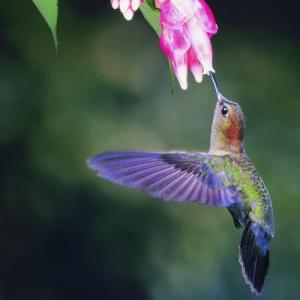 After comparing the brains of hummingbirds to those of other birds, scientists found that a specific nucleus (in this case, a "nucleus" refers to a distinct brain region) that detects any movement of the entire visual world. They found that this brain nuclei was two to five times bigger in the hummingbird than in any other species, relative to brain size.
After comparing the brains of hummingbirds to those of other birds, scientists found that a specific nucleus (in this case, a "nucleus" refers to a distinct brain region) that detects any movement of the entire visual world. They found that this brain nuclei was two to five times bigger in the hummingbird than in any other species, relative to brain size.
"We reasoned that this nucleus helps the hummingbird stay stationary in space, even while they're flying," said said Doug Wong-Wylie, Canada Research Chair in Behavioural and Systems Neuroscience and psychology professor at the University of Alberta. "These birds must have a good optomotor response considering they are stationary 90 per cent of the time. This specific nuclei is likely responsible for that."
This brain nuclei helps the bird to hover and feed while on the wing. Hummingbirds are known for their rapid wing beats and ability to hover and fly forward and backward with great precision. Additionally, it is critical that the hummingbird remain perfectly still as it feeds while darting in and out of flower blossoms with pinpoint accuracy. The bird must be able to maintain a stable position in space, despite the fact that their wings are beating 75 times per second while compensating for disruptive effects such as wind gusts.
Much work has been done on the hummingbirds' physiological make up--such as its enlarged heart, high metabolic rate and specialized wing kinematics -- but nothing has been done on the neural specializations of the bird. "Part of the reason this type of work hasn't been done before is because of access to the birds," said Iwaniuk. "In Canada especially they tend to be uncommon, they come from exotic locales and they are not easy to catch, so we were very fortunate to be able to study the specimens we did."
Wong-Wylie and Dr. Andrew Iwaniuk, also from the Department of Psychology in the Faculty of Science, compared hummingbird brains to 28 other bird species, obtained from the National Museum of Natural History, the Field Museum of Natural History, and the Louisiana State University Museum of Natural Science.
[.. ]
Wong-Wylie and Iwaniuk plan to continue this line of research and have hummingbirds track visual motion while watching the nucleus to see how it reacts.
This research is published early online in The Journal of Comparative Neurology and will come out in its print edition in January.
Cited story.

Fascinating...
Amazing....
I would love knowing more about your research.
I am fascinated to hummingbirds and I believe I will always be.
Thank you.
Wilma Stein
I LOVE HUMMINGBIRDS ,AND I WOULD LOVE TO HAVE A PICTURE OF ONE .
THANK YOU
KIM